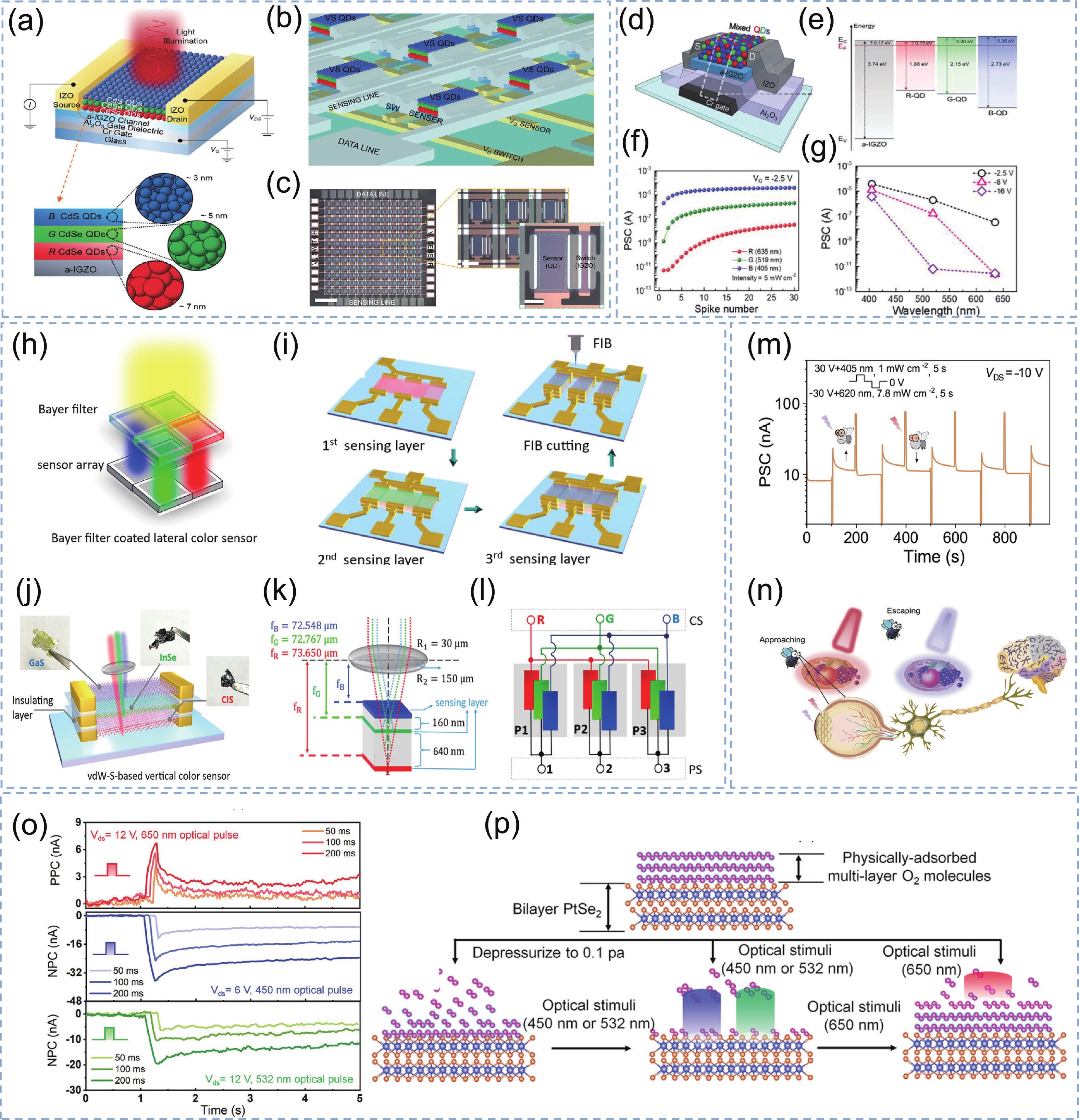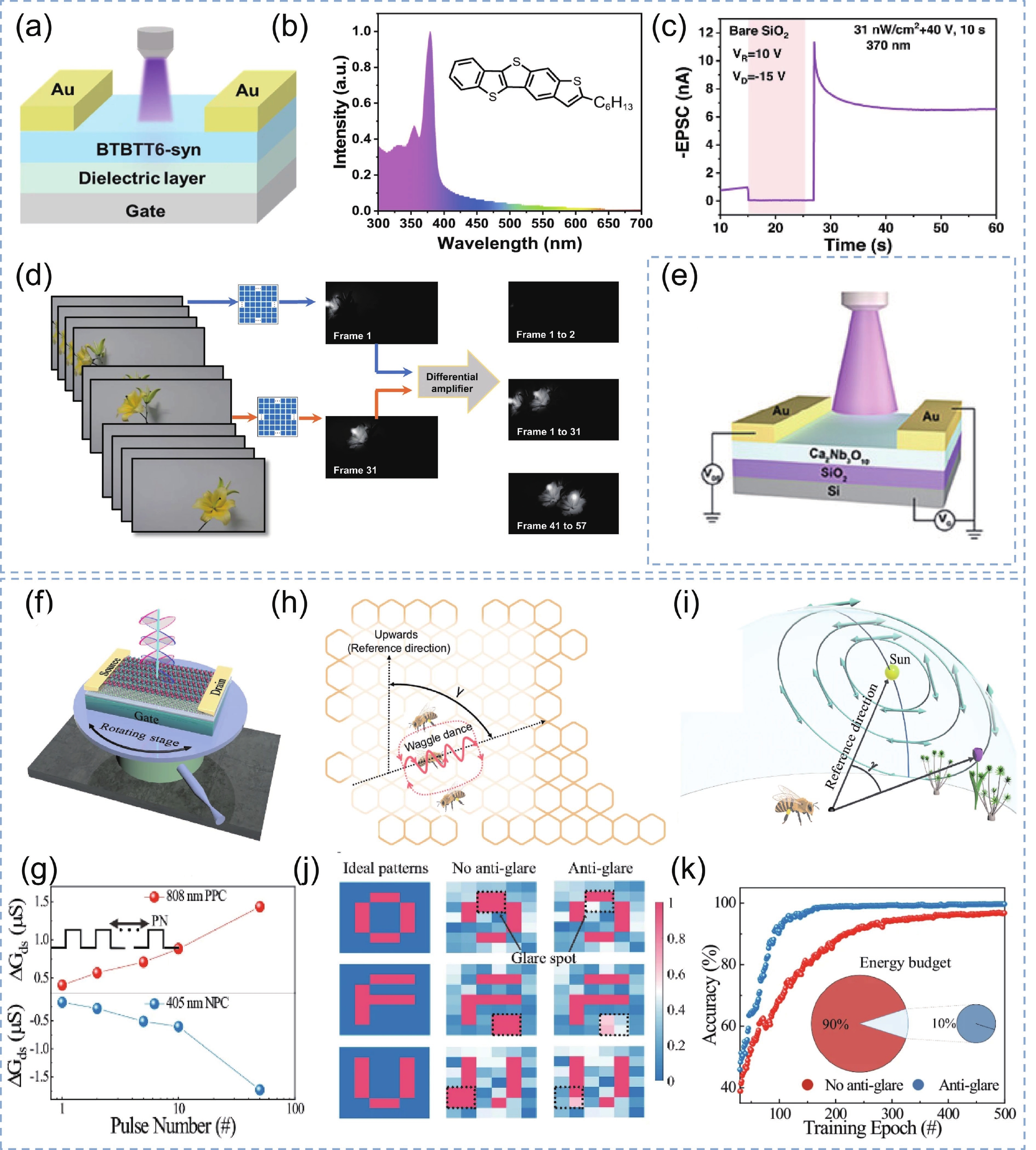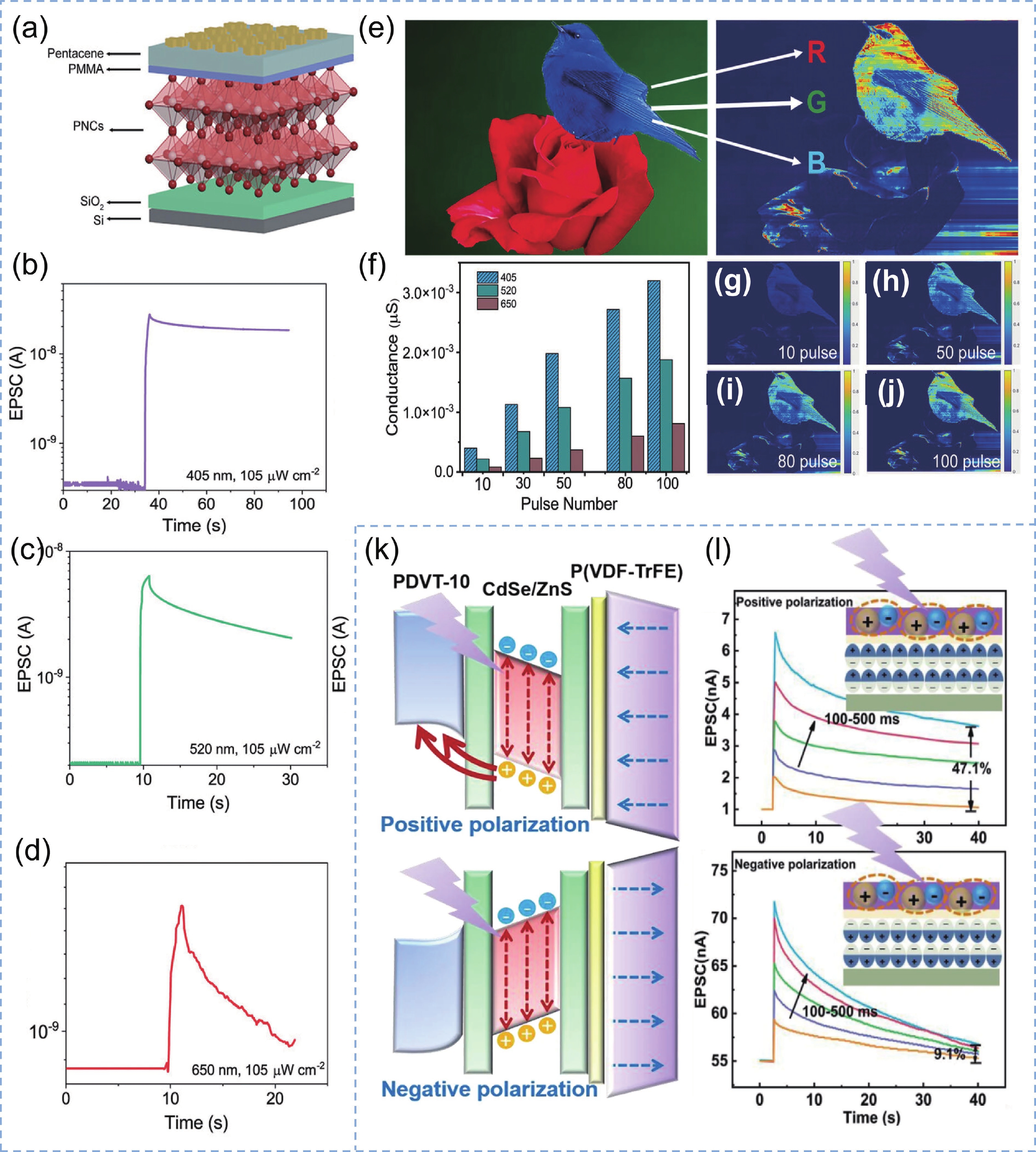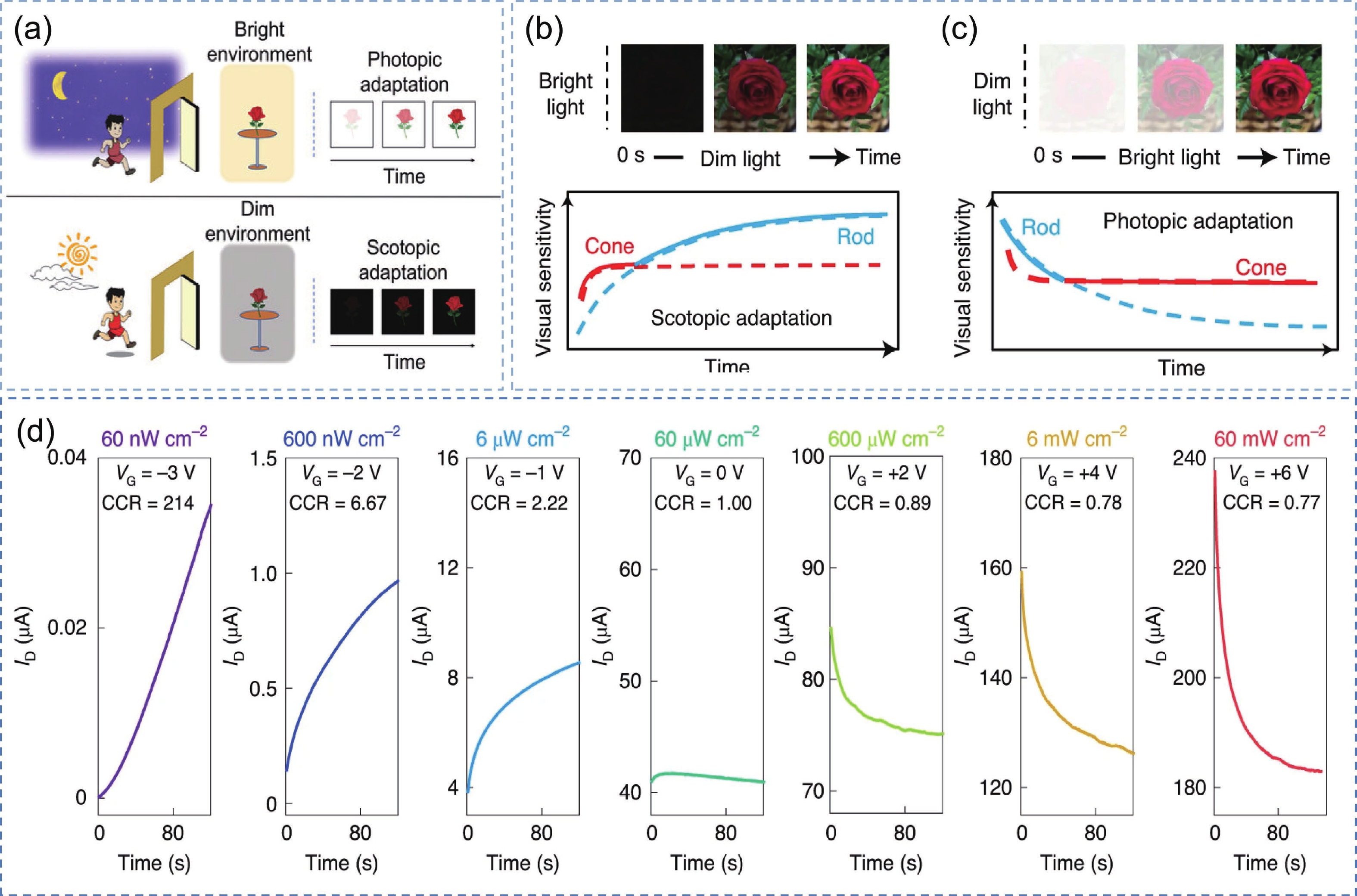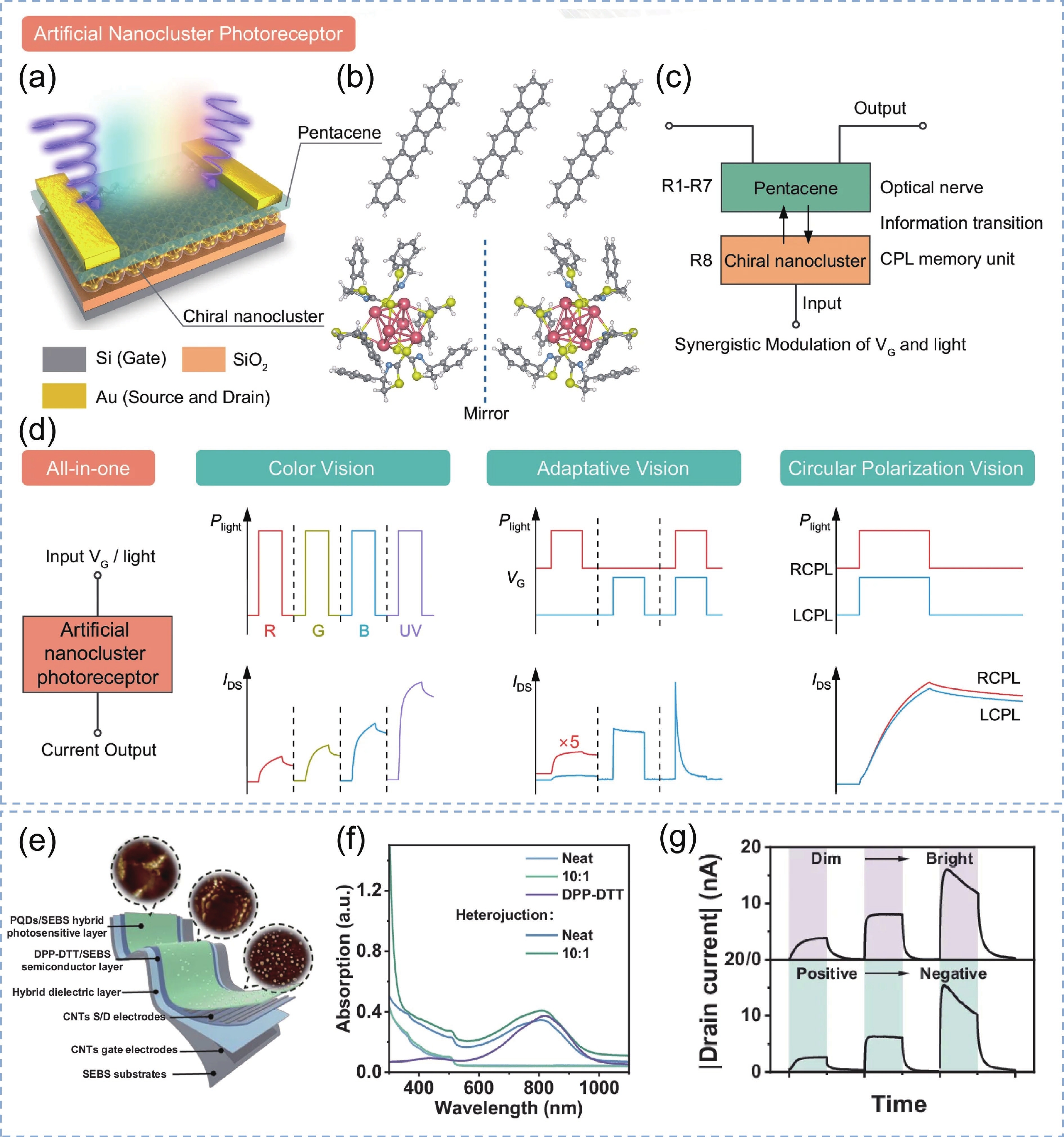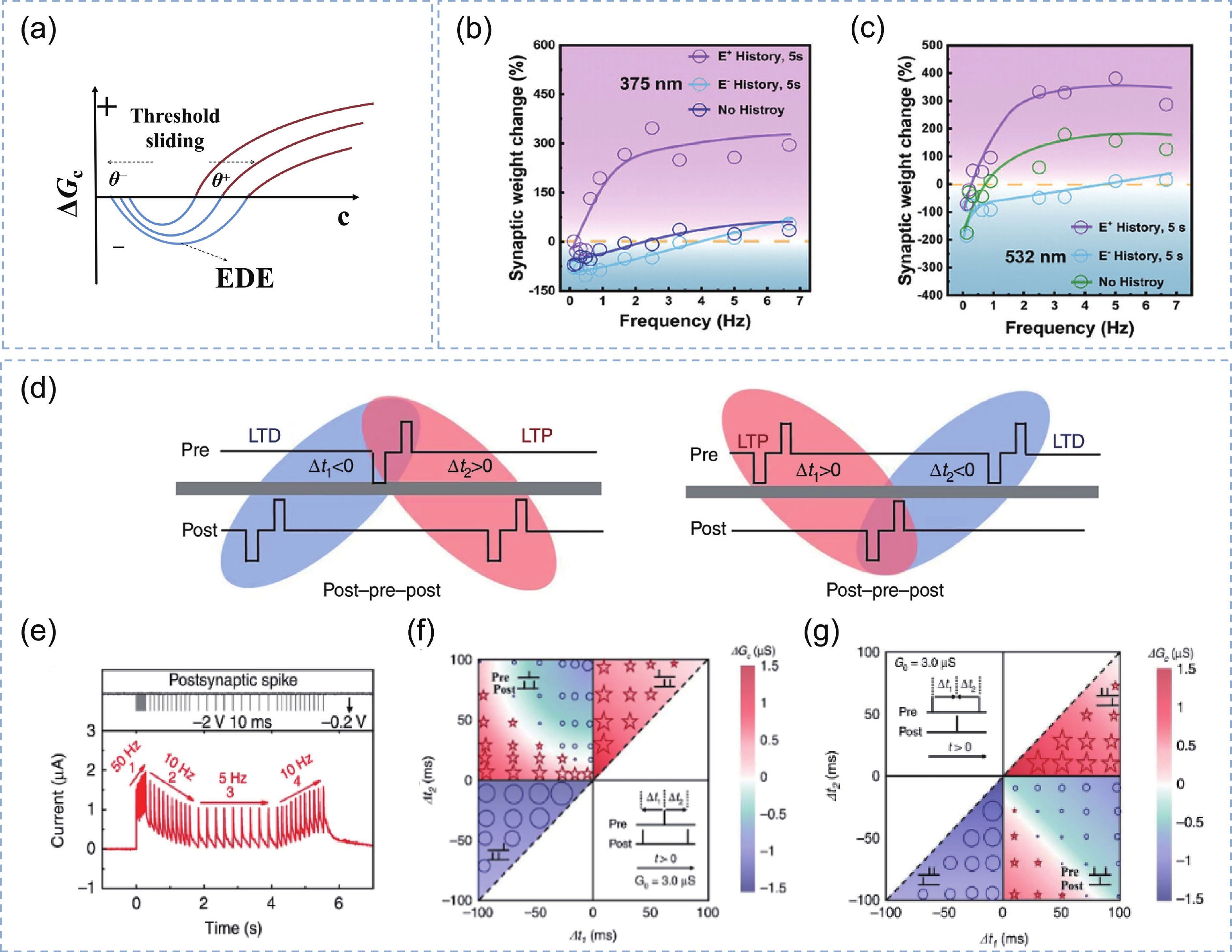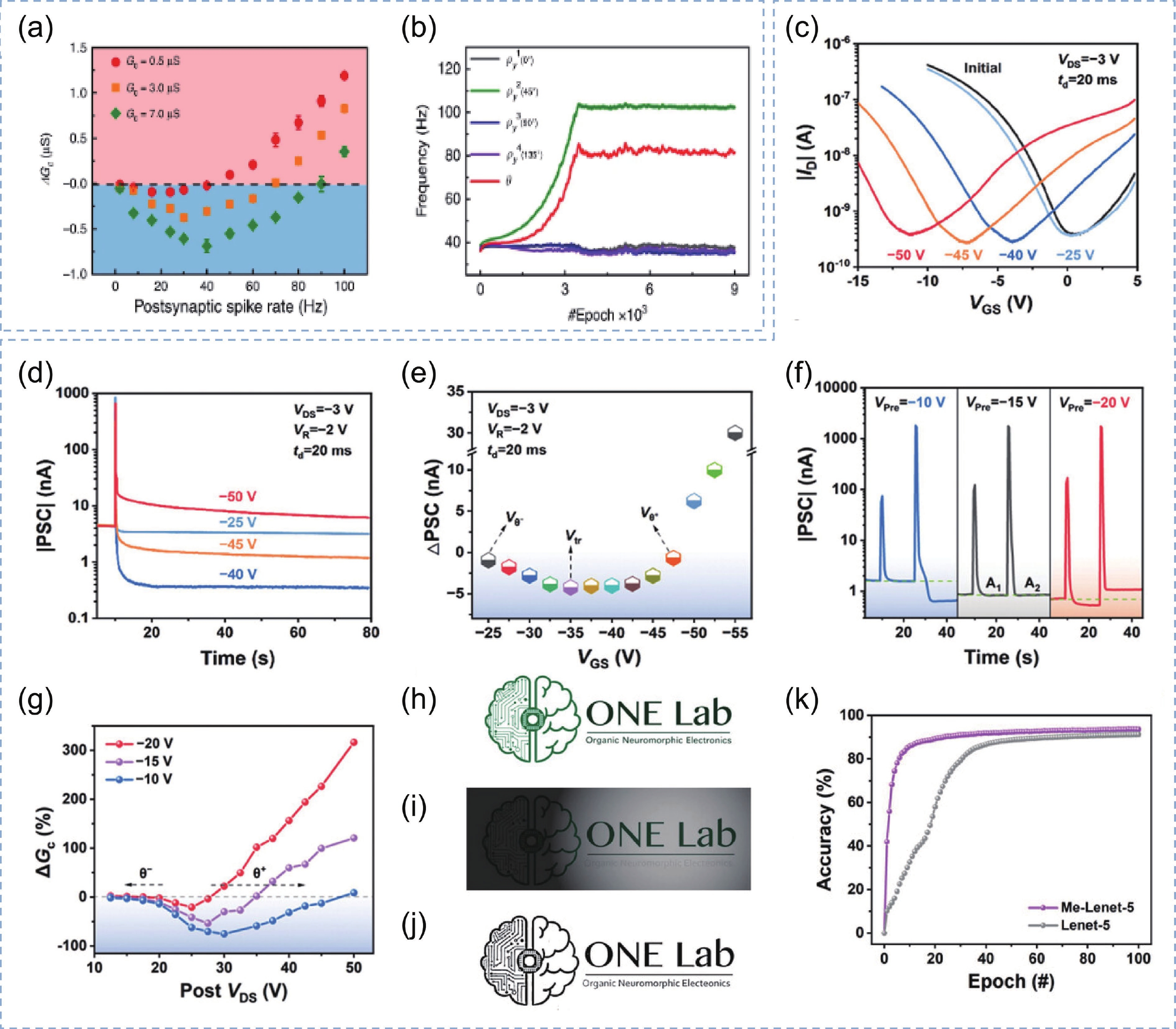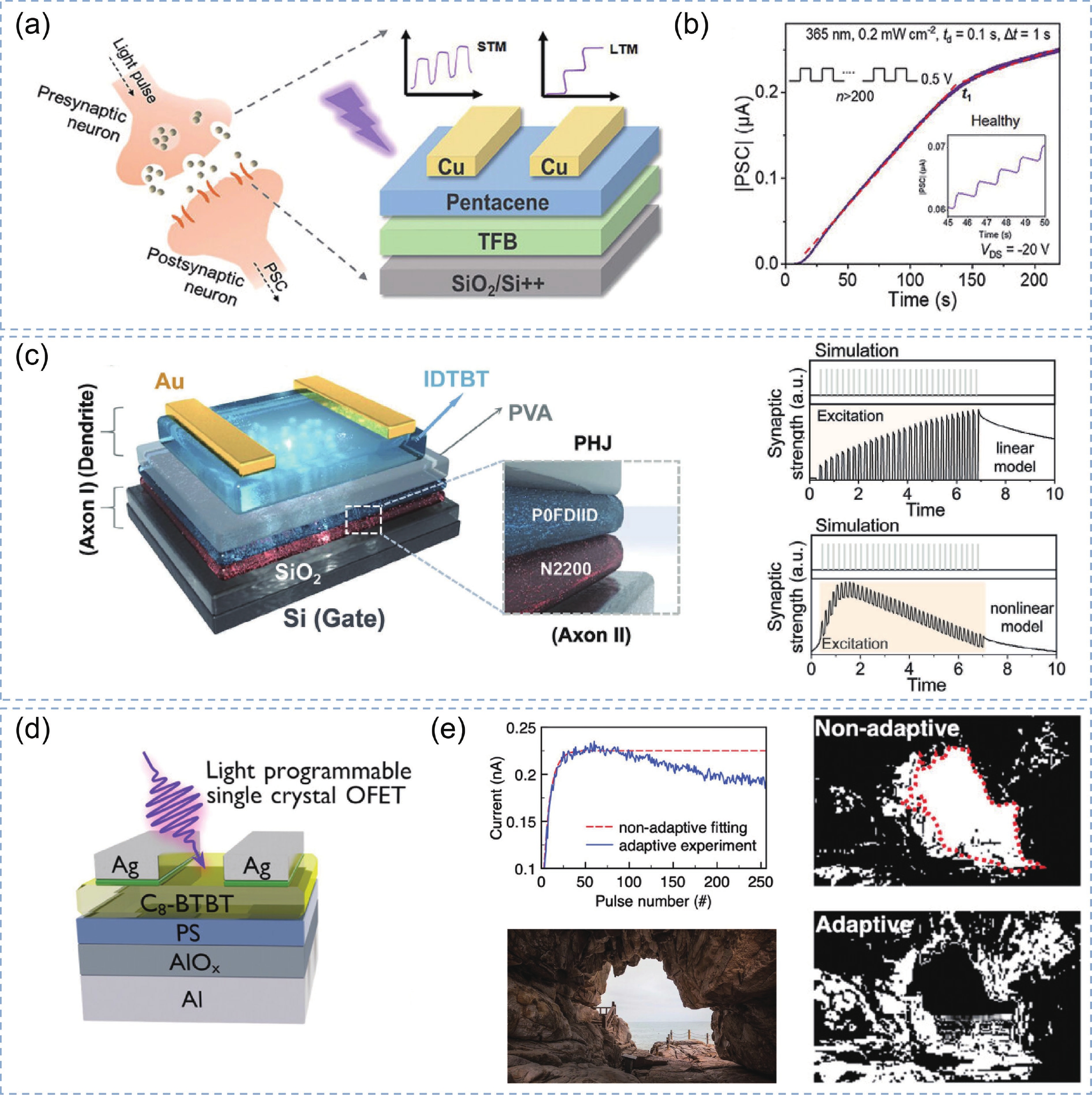| Citation: |
Yiru Wang, Shanshuo Liu, Hongxin Zhang, Yuchen Cao, Zitong Mu, Mingdong Yi, Linghai Xie, Haifeng Ling. Adaptive optoelectronic transistor for intelligent vision system[J]. Journal of Semiconductors, 2025, 46(2): 021404. doi: 10.1088/1674-4926/24100042
****
Y R Wang, S S Liu, H X Zhang, Y C Cao, Z T Mu, M D Yi, L H Xie, and H F Ling, Adaptive optoelectronic transistor for intelligent vision system[J]. J. Semicond., 2025, 46(2), 021404 doi: 10.1088/1674-4926/24100042
|
Adaptive optoelectronic transistor for intelligent vision system
DOI: 10.1088/1674-4926/24100042
CSTR: 32376.14.1674-4926.24100042
More Information-
Abstract
Recently, for developing neuromorphic visual systems, adaptive optoelectronic devices become one of the main research directions and attract extensive focus to achieve optoelectronic transistors with high performances and flexible functionalities. In this review, based on a description of the biological adaptive functions that are favorable for dynamically perceiving, filtering, and processing information in the varying environment, we summarize the representative strategies for achieving these adaptabilities in optoelectronic transistors, including the adaptation for detecting information, adaptive synaptic weight change, and history-dependent plasticity. Moreover, the key points of the corresponding strategies are comprehensively discussed. And the applications of these adaptive optoelectronic transistors, including the adaptive color detection, signal filtering, extending the response range of light intensity, and improve learning efficiency, are also illustrated separately. Lastly, the challenges faced in developing adaptive optoelectronic transistor for artificial vision system are discussed. The description of biological adaptive functions and the corresponding inspired neuromorphic devices are expected to provide insights for the design and application of next-generation artificial visual systems. -
References
[1] Liao F Y, Zhou Z, Kim B J, et al. Bioinspired in-sensor visual adaptation for accurate perception. Nat Electron, 2022, 5(2), 84 doi: 10.1038/s41928-022-00713-1[2] Bao R, Wang S Y, Liu X X, et al. Neuromorphic electro-stimulation based on atomically thin semiconductor for damage-free inflammation inhibition. Nat Commun, 2024, 15(1), 1327 doi: 10.1038/s41467-024-45590-8[3] Peng Z R, Tong L, Shi W H, et al. Multifunctional human visual pathway-replicated hardware based on 2D materials. Nat Commun, 2024, 15(1), 8650 doi: 10.1038/s41467-024-52982-3[4] Park J, Kim M S, Kim J, et al. Avian eye-inspired perovskite artificial vision system for foveated and multispectral imaging. Sci Robot, 2024, 9(90), eadk6903 doi: 10.1126/scirobotics.adk6903[5] Jiang H, Tsoi C C, Yu W X, et al. Optical fibre based artificial compound eyes for direct static imaging and ultrafast motion detection. Light Sci Appl, 2024, 13(1), 256 doi: 10.1038/s41377-024-01580-5[6] Jayachandran D, Oberoi A, Sebastian A, et al. A low-power biomimetic collision detector based on an in-memory molybdenum disulfide photodetector. Nat Electron, 2020, 3(10), 646 doi: 10.1038/s41928-020-00466-9[7] John R A. An adaptive device for AI neural networks. Science, 2022, 375(6580), 495 doi: 10.1126/science.abn6196[8] Chai Y. In-sensor computing for machine vision. Nature, 2020, 579(7797), 32 doi: 10.1038/d41586-020-00592-6[9] Mehonic A, Kenyon A. Brain-inspired computing needs a master plan. Nature, 2022, 604(7905), 255 doi: 10.1038/s41586-021-04362-w[10] Pang X C, Wang Y, Zhu Y Y, et al. Non-volatile rippled-assisted optoelectronic array for all-day motion detection and recognition. Nat Commun, 2024, 15(1), 1613 doi: 10.1038/s41467-024-46050-z[11] Luo X, Chen C, He Z X, et al. A bionic self-driven retinomorphic eye with ionogel photosynaptic retina. Nat Commun, 2024, 15(1), 3086 doi: 10.1038/s41467-024-47374-6[12] Li P Z, Zhang M Z, Zhou Q L, et al. Reconfigurable optoelectronic transistors for multimodal recognition. Nat Commun, 2024, 15(1), 3257 doi: 10.1038/s41467-024-47580-2[13] Jo C, Kim J, Kwak J Y, et al. Retina-inspired color-cognitive learning via chromatically controllable mixed quantum dot synaptic transistor arrays. Adv Mater, 2022, 34(12), 2108979 doi: 10.1002/adma.202108979[14] Xie D D, Gao G, Tian B B, et al. Porous metal–organic framework/ReS2 heterojunction phototransistor for polarization-sensitive visual adaptation emulation. Adv Mater, 2023, 35(26), 2212118 doi: 10.1002/adma.202212118[15] Guo T, Li S S, Zhou Y N, et al. Interspecies-chimera machine vision with polarimetry for real-time navigation and anti-glare pattern recognition. Nat Commun, 2024, 15(1), 6731 doi: 10.1038/s41467-024-51178-z[16] Song J K, Kim J, Yoon J, et al. Stretchable colour-sensitive quantum dot nanocomposites for shape-tunable multiplexed phototransistor arrays. Nat Nanotechnol, 2022, 17(8), 849 doi: 10.1038/s41565-022-01160-x[17] Jiang T, Wang Y R, Zheng Y S, et al. Tetrachromatic vision-inspired neuromorphic sensors with ultraweak ultraviolet detection. Nat Commun, 2023, 14(1), 2281 doi: 10.1038/s41467-023-37973-0[18] Chen R Q, Yang H Z, Li R Y, et al. Thin-film transistor for temporal self-adaptive reservoir computing with closed-loop architecture. Sci Adv, 2024, 10(7), eadl1299 doi: 10.1126/sciadv.adl1299[19] Ma Y, Shan L T, Ying Y R, et al. Day-Night imaging without infrared cutfilter removal based on metal-gradient perovskite single crystal photodetector. Nat Commun, 2024, 15(1), 7516 doi: 10.1038/s41467-024-51762-3[20] Zhang T, Guo X, Wang P, et al. High performance artificial visual perception and recognition with a plasmon-enhanced 2D material neural network. Nat Commun, 2024, 15(1), 2471 doi: 10.1038/s41467-024-46867-8[21] Zhang S, Chen R Z, Kong D R, et al. Photovoltaic nanocells for high-performance large-scale-integrated organic phototransistors. Nat Nanotechnol, 2024, 19(9), 1323 doi: 10.1038/s41565-024-01707-0[22] Kumar S, Wang X X, Strachan J P, et al. Dynamical memristors for higher-complexity neuromorphic computing. Nat Rev Mater, 2022, 7(7), 575 doi: 10.1038/s41578-022-00434-z[23] Zhang H C, Liang F Z, Yang L, et al. Superior AlGaN/GaN-based phototransistors and arrays with reconfigurable triple-mode functionalities enabled by voltage-programmed two-dimensional electron gas for high-quality imaging. Adv Mater, 2024, 36(36), 2405874[24] Li T X, Miao J S, Fu X, et al. Reconfigurable, non-volatile neuromorphic photovoltaics. Nat Nanotechnol, 2023, 18(11), 1303 doi: 10.1038/s41565-023-01446-8[25] Orgiu E, Crivillers N, Herder M, et al. Optically switchable transistor via energy-level phototuning in a bicomponent organic semiconductor. Nat Chem, 2012, 4(8), 675 doi: 10.1038/nchem.1384[26] Shao H, Li Y Q, Chen J F, et al. Mimicking evasive behavior in wavelength-dependent reconfigurable phototransistors with ultralow power consumption. SmartMat, 2024, 5(4), e1230 doi: 10.1002/smm2.1230[27] Shao H, Li Y Q, Yang W, et al. A reconfigurable optoelectronic synaptic transistor with stable Zr-CsPbI3 nanocrystals for visuomorphic computing. Adv Mater, 2023, 35(12), 2208497 doi: 10.1002/adma.202208497[28] He Z H, Shen H G, Ye D K, et al. An organic transistor with light intensity-dependent active photoadaptation. Nat Electron, 2021, 4(7), 522 doi: 10.1038/s41928-021-00615-8[29] Wang Y R, Nie S M, Liu S S, et al. Dual-adaptive heterojunction synaptic transistors for efficient machine vision in harsh lighting conditions. Adv Mater, 2024, 36(32), 2404160 doi: 10.1002/adma.202404160[30] Gao C S, Liu D, Xu C H, et al. Feedforward photoadaptive organic neuromorphic transistor with mixed-weight plasticity for augmenting perception. Adv Funct Mater, 2024, 34(18), 2313217 doi: 10.1002/adfm.202313217[31] Wu X S, Wang S C, Huang W, et al. Wearable in-sensor reservoir computing using optoelectronic polymers with through-space charge-transport characteristics for multi-task learning. Nat Commun, 2023, 14(1), 468 doi: 10.1038/s41467-023-36205-9[32] Liu X, Wang D H, Chen W, et al. Optoelectronic synapses with chemical-electric behaviors in gallium nitride semiconductors for biorealistic neuromorphic functionality. Nat Commun, 2024, 15(1), 7671 doi: 10.1038/s41467-024-51194-z[33] Lee J, Jeong B H, Kamaraj E, et al. Light-enhanced molecular polarity enabling multispectral color-cognitive memristor for neuromorphic visual system. Nat Commun, 2023, 14(1), 5775 doi: 10.1038/s41467-023-41419-y[34] Shi J J, Lin Y, Wang Z Q, et al. Adaptive processing enabled by sodium alginate based complementary memristor for neuromorphic sensory system. Adv Mater, 2024, 36(32), 2314156 doi: 10.1002/adma.202314156[35] Huang P Y, Jiang B Y, Chen H J, et al. Neuro-inspired optical sensor array for high-accuracy static image recognition and dynamic trace extraction. Nat Commun, 2023, 14(1), 6736 doi: 10.1038/s41467-023-42488-9[36] Kim J, Jo C, Kim M G, et al. Vertically stacked full color quantum dots phototransistor arrays for high-resolution and enhanced color-selective imaging. Adv Mater, 2022, 34(2), 2106215 doi: 10.1002/adma.202106215[37] Tan Y L, Hao H, Chen Y B, et al. A bioinspired retinomorphic device for spontaneous chromatic adaptation. Adv Mater, 2022, 34(51), 2206816 doi: 10.1002/adma.202206816[38] Kim J, Kwon S M, Kang Y K, et al. A skin-like two-dimensionally pixelized full-color quantum dot photodetector. Sci Adv, 2019, 5(11), eaax8801 doi: 10.1126/sciadv.aax8801[39] Kim J, Kim J, Jo S, et al. Ultrahigh detective heterogeneous photosensor arrays with In-pixel signal boosting capability for large-area and skin-compatible electronics. Adv Mater, 2016, 28(16), 3078 doi: 10.1002/adma.201505149[40] Pierre A, Gaikwad A, Arias A C. Charge-integrating organic heterojunction phototransistors for wide-dynamic-range image sensors. Nat Photonics, 2017, 11(3), 193 doi: 10.1038/nphoton.2017.15[41] Li N X, Okmi A, Jabegu T, et al. Van der waals semiconductor empowered vertical color sensor. ACS Nano, 2022, 16(6), 8619 doi: 10.1021/acsnano.1c09875[42] Su Z J, Yan Y, Sun M R, et al. Broadband artificial tetrachromatic synaptic devices composed of 2D/3D integrated WSe2-GaN-based dual-channel floating gate transistors. Adv Funct Mater, 2024, 34(33), 2316802 doi: 10.1002/adfm.202316802[43] Park H L, Kim H, Lim D, et al. Retina-inspired carbon nitride-based photonic synapses for selective detection of UV light. Adv Mater, 2020, 32(11), 1906899 doi: 10.1002/adma.201906899[44] Hu L F, Yan J, Liao M Y, et al. An optimized ultraviolet-a light photodetector with wide-range photoresponse based on ZnS/ZnO biaxial nanobelt. Adv Mater, 2012, 24(17), 2305 doi: 10.1002/adma.201200512[45] Pan S S, Liu Q W, Zhao J Q, et al. Ultrahigh detectivity and wide dynamic range ultraviolet photodetectors based on Bi xSn1– xO2 intermediate band semiconductor. ACS Appl Mater Interfaces, 2017, 9(34), 28737 doi: 10.1021/acsami.7b06058[46] Zhang Z F, Zhao X L, Zhang X M, et al. In-sensor reservoir computing system for latent fingerprint recognition with deep ultraviolet photo-synapses and memristor array. Nat Commun, 2022, 13(1), 6590 doi: 10.1038/s41467-022-34230-8[47] Chen J X, Liu X Y, Zhu Q S, et al. 2D Ca2Nb3O10 optoelectronic neuromorphic device for ultrasensitive UV-C vision and encrypted communication. Adv Funct Mater, 2024, 34(38), 2402684 doi: 10.1002/adfm.202402684[48] Zhang Z D, Gao X, Zhong Y N, et al. Selective solar-blind UV monitoring based on organic field-effect transistor nonvolatile memories. Adv Electron Mater, 2017, 3(8), 1700052 doi: 10.1002/aelm.201700052[49] Wang F K, Hu F C, Dai M J, et al. A two-dimensional mid-infrared optoelectronic retina enabling simultaneous perception and encoding. Nat Commun, 2023, 14(1), 1938 doi: 10.1038/s41467-023-37623-5[50] Shao H, Ji Y, Wang R H, et al. Optically enhanced organic phototransistors for adaptive image processing under complex light conditions. Nano Energy, 2024, 130, 110133 doi: 10.1016/j.nanoen.2024.110133[51] Powell S B, Garnett R, Marshall J, et al. Bioinspired polarization vision enables underwater geolocalization. Sci Adv, 2018, 4(4), eaao6841 doi: 10.1126/sciadv.aao6841[52] Krapp H G. Polarization vision: How insects find their way by watching the sky. Curr Biol, 2007, 17(14), 557 doi: 10.1016/j.cub.2007.05.022[53] Gomes Silva C, Luz I, Llabrés i Xamena F X, et al. Water stable Zr–benzenedicarboxylate metal–organic frameworks as photocatalysts for hydrogen generation. Chem, 2010, 16(36), 11133 doi: 10.1002/chem.200903526[54] Long J L, Wang S B, Ding Z X, et al. Amine-functionalized zirconium metal-organic framework as efficient visible-light photocatalyst for aerobic organic transformations. Chem Commun, 2012, 48(95), 11656 doi: 10.1039/c2cc34620f[55] Nicholls L H, Rodríguez-Fortuño F J, Nasir M E, et al. Ultrafast synthesis and switching of light polarization in nonlinear anisotropic metamaterials. Nat Photonics, 2017, 11(10), 628 doi: 10.1038/s41566-017-0002-6[56] Wang X B, Wang Y, Gao W Y, et al. Polarization-sensitive halide perovskites for polarized luminescence and detection: Recent advances and perspectives. Adv Mater, 2021, 33(12), 2003615 doi: 10.1002/adma.202003615[57] Pan J, Wu Y M, Zhang X J, et al. Anisotropic charge trapping in phototransistors unlocks ultrasensitive polarimetry for bionic navigation. Nat Commun, 2022, 13(1), 6629 doi: 10.1038/s41467-022-34421-3[58] Zhu K C, Pazos S, Aguirre F, et al. Hybrid 2D–CMOS microchips for memristive applications. Nature, 2023, 618(7963), 57 doi: 10.1038/s41586-023-05973-1[59] John R A, Acharya J, Zhu C, et al. Optogenetics inspired transition metal dichalcogenide neuristors for in-memory deep recurrent neural networks. Nat Commun, 2020, 11(1), 3211 doi: 10.1038/s41467-020-16985-0[60] Tongay S, Sahin H, Ko C, et al. Monolayer behaviour in bulk ReS2 due to electronic and vibrational decoupling. Nat Commun, 2014, 5, 3252 doi: 10.1038/ncomms4252[61] Xiang D, Liu T, Wang J Y, et al. Anomalous broadband spectrum photodetection in 2D rhenium disulfide transistor. Adv Optical Mater, 2019, 7(23), 1901115 doi: 10.1002/adom.201901115[62] Upadhyay N K, Jiang H, Wang Z R, et al. Emerging memory devices for neuromorphic computing. Adv Mater Technol, 2019, 4(4), 1800589 doi: 10.1002/admt.201800589[63] van de Burgt Y, Lubberman E, Fuller E J, et al. A non-volatile organic electrochemical device as a low-voltage artificial synapse for neuromorphic computing. Nat Mater, 2017, 16(4), 414 doi: 10.1038/nmat4856[64] Zhu M L, He T, Lee C K. Technologies toward next generation human machine interfaces: From machine learning enhanced tactile sensing to neuromorphic sensory systems. Appl Phys Rev, 2020, 7(3), 031305 doi: 10.1063/5.0016485[65] Wang Z Q, Xu H Y, Li X H, et al. Synaptic learning and memory functions achieved using oxygen ion migration/diffusion in an amorphous InGaZnO memristor. Adv Funct Mater, 2012, 22(13), 2759 doi: 10.1002/adfm.201103148[66] Sun Y L, Ding Y T, Xie D, et al. Optogenetics-inspired neuromorphic optoelectronic synaptic transistors with optically modulated plasticity. Adv Optical Mater, 2021, 9(12), 2002232 doi: 10.1002/adom.202002232[67] Wang L, Zheng C Y, Fu J W, et al. Influence of molecular weight of polymer electret on the synaptic organic field-effect transistor performance. Adv Electron Mater, 2022, 8(9), 2200155 doi: 10.1002/aelm.202200155[68] Bartolozzi C, Indiveri G. Selective attention implemented with dynamic synapses and integrate-and-fire neurons. Neurocomputing, 2006, 69(16-18), 1971 doi: 10.1016/j.neucom.2005.06.022[69] Green C S, Bavelier D. Action video game modifies visual selective attention. Nature, 2003, 423(6939), 534 doi: 10.1038/nature01647[70] Linden M A, Crothers I R, Rauch R J. Exploring eye movement analysis as a measure of selective visual attention in brain injured individuals. Brain Inj, 2006, 20(2), 143 doi: 10.1080/02699050500442840[71] Thorpe S, Fize D, Marlot C. Speed of processing in the human visual system. Nature, 1996, 381(6582), 520 doi: 10.1038/381520a0[72] Fries P, Reynolds J H, Rorie A E, et al. Modulation of oscillatory neuronal synchronization by selective visual attention. Science, 2001, 291(5508), 1560 doi: 10.1126/science.1055465[73] You W K, Mysore S P. Endogenous and exogenous control of visuospatial selective attention in freely behaving mice. Nat Commun, 2020, 11(1), 1986 doi: 10.1038/s41467-020-15909-2[74] Ouyang B S, Wang J L, Zeng G, et al. Bioinspired in-sensor spectral adaptation for perceiving spectrally distinctive features. Nat Electron, 2024, 7(8), 705 doi: 10.1038/s41928-024-01208-x[75] Duan S M, Zhang X H, Xi Y, et al. Solution-processed ultralow voltage organic transistors with sharp switching for adaptive visual perception. Adv Mater, 2024, 36(32), 2405030 doi: 10.1002/adma.202405030[76] Wang H, Lu Y L, Liu S B, et al. Adaptive neural activation and neuromorphic processing via drain-injection threshold-switching float gate transistor memory. Adv Mater, 2023, 35(52), 2309099 doi: 10.1002/adma.202309099[77] Zhang M, Gu Z H, Pan G. A survey of neuromorphic computing based on spiking neural networks. Chinese J Electron, 2018, 27(4), 667 doi: 10.1049/cje.2018.05.006[78] Yu R J, He L H, Gao C S, et al. Programmable ferroelectric bionic vision hardware with selective attention for high-precision image classification. Nat Commun, 2022, 13(1), 7019 doi: 10.1038/s41467-022-34565-2[79] Gao Z X, Ju X, Zhang H Z, et al. InP quantum dots tailored oxide thin film phototransistor for bioinspired visual adaptation. Adv Funct Mater, 2023, 33(52), 2305959 doi: 10.1002/adfm.202305959[80] Mennel L, Symonowicz J, Wachter S, et al. Ultrafast machine vision with 2D material neural network image sensors. Nature, 2020, 579(7797), 62 doi: 10.1038/s41586-020-2038-x[81] Zhou F C, Chai Y. Near-sensor and in-sensor computing. Nat Electron, 2020, 3(11), 664 doi: 10.1038/s41928-020-00501-9[82] Liao F Y, Zhou F C, Chai Y. Neuromorphic vision sensors, principle, progress and perspectives. J Semicond, 2021, 42(1), 013105 doi: 10.1088/1674-4926/42/1/013105[83] Uddin D, Jeffrey B G, Flynn O, et al. Repeatability of scotopic sensitivity and dark adaptation using a medmont dark-adapted chromatic perimeter in age-related macular degeneration. Transl Vis Sci Technol, 2020, 9(7), 31 doi: 10.1167/tvst.9.7.31[84] Lee T J, Yun K R, Kim S K, et al. Realization of an artificial visual nervous system using an integrated optoelectronic device array. Adv Mater, 2021, 33(51), 2105485 doi: 10.1002/adma.202105485[85] Subbulakshmi Radhakrishnan S, Chakrabarti S, Sen D, et al. A sparse and spike-timing-based adaptive photoencoder for augmenting machine vision for spiking neural networks. Adv Mater, 2022, 34(48), 2202535 doi: 10.1002/adma.202202535[86] Kumar M, Lim J, Kim S, et al. Environment-adaptable photonic–electronic-coupled neuromorphic angular visual system. ACS Nano, 2020, 14(10), 14108 doi: 10.1021/acsnano.0c06874[87] Zhang M Y, Chi Z G, Wang G Q, et al. An irradiance-adaptable near-infrared vertical heterojunction phototransistor. Adv Mater, 2022, 34(40), 2205679 doi: 10.1002/adma.202205679[88] Wen W, Liu G C, Wei X F, et al. Biomimetic nanocluster photoreceptors for adaptative circular polarization vision. Nat Commun, 2024, 15(1), 2397 doi: 10.1038/s41467-024-46646-5[89] Zhang Y, Lang C L, Fan J Z, et al. High mobility multibit nonvolatile memory elements based organic field effect transistors with large hysteresis. Org Electron, 2016, 35(1), 53[90] Long Z H, Qiu X, Chan C L J, et al. A neuromorphic bionic eye with filter-free color vision using hemispherical perovskite nanowire array retina. Nat Commun, 2023, 14(1), 1972 doi: 10.1038/s41467-023-37581-y[91] Liu Y J, Ji Z, Cen G B, et al. Perovskite-based color camera inspired by human visual cells. Light Sci Appl, 2023, 12(1), 43 doi: 10.1038/s41377-023-01072-y[92] Kwon S M, Cho S W, Kim M, et al. Environment-adaptable artificial visual perception behaviors using a light-adjustable optoelectronic neuromorphic device array. Adv Mater, 2019, 31(52), 1906433 doi: 10.1002/adma.201906433[93] Wang C Y, Bian Y S, Liu K, et al. Strain-insensitive viscoelastic perovskite film for intrinsically stretchable neuromorphic vision-adaptive transistors. Nat Commun, 2024, 15(1), 3123 doi: 10.1038/s41467-024-47532-w[94] Mante V, Frazor R A, Bonin V, et al. Independence of luminance and contrast in natural scenes and in the early visual system. Nat Neurosci, 2005, 8(12), 1690 doi: 10.1038/nn1556[95] Zliobaite I, Gabrys B. Adaptive preprocessing for streaming data. IEEE Trans Knowl Data Eng, 2014, 26(2), 309 doi: 10.1109/TKDE.2012.147[96] Lee Y R, Trung T Q, Hwang B U, et al. A flexible artificial intrinsic-synaptic tactile sensory organ. Nat Commun, 2020, 11(1), 2753 doi: 10.1038/s41467-020-16606-w[97] Liu W Z, Yang X H, Wang Z Q, et al. Self-powered and broadband opto-sensor with bionic visual adaptation function based on multilayer γ-InSe flakes. Light Sci Appl, 2023, 12(1), 180 doi: 10.1038/s41377-023-01223-1[98] Wang Y R, Hua J, He X, et al. Adaptive optoelectronic transistor enabled by nanoporous patterning for low-contrast image recognition. Adv Funct Mater, 2024 doi: 10.1002/adfm.202414546[99] Caporale N, Dan Y. Spike timing–dependent plasticity: A hebbian learning rule. Annu Rev Neurosci, 2008, 31, 25 doi: 10.1146/annurev.neuro.31.060407.125639[100] Turrigiano G G, Leslie K R, Desai N S, et al. Activity-dependent scaling of quantal amplitude in neocortical neurons. Nature, 1998, 391(6670), 892 doi: 10.1038/36103[101] Turrigiano G G, Nelson S B. Homeostatic plasticity in the developing nervous system. Nat Rev Neurosci, 2004, 5(2), 97 doi: 10.1038/nrn1327[102] Bienenstock E L, Cooper L N, Munro P W. Theory for the development of neuron selectivity, orientation specificity and binocular interaction in visual cortex. J Neurosci, 1982, 2(1), 79[103] John R A, Yantara N, Ng Y F, et al. Ionotronic halide perovskite drift-diffusive synapses for low-power neuromorphic computation. Adv Mater, 2018, 30(51), 1805454 doi: 10.1002/adma.201805454[104] John R A, Yantara N, Ng S E, et al. Diffusive and drift halide perovskite memristive barristors as nociceptive and synaptic emulators for neuromorphic computing. Adv Mater, 2021, 33(15), 2007851 doi: 10.1002/adma.202007851[105] MacDonald J F, Jackson M F, Beazely M A. G protein-coupled receptors control NMDARs and metaplasticity in the hippocampus. Biochim Biophys Acta BBA Biomembr, 2007, 1768(4), 941 doi: 10.1016/j.bbamem.2006.12.006[106] Hulme S R, Jones O D, Abraham W C. Emerging roles of metaplasticity in behaviour and disease. Trends Neurosci, 2013, 36(6), 353 doi: 10.1016/j.tins.2013.03.007[107] Ngezahayo A, Schachner M, Artola A. Synaptic activity modulates the induction of bidirectional synaptic changes in adult mouse hippocampus. J Neurosci, 2000, 20(7), 2451 doi: 10.1523/JNEUROSCI.20-07-02451.2000[108] Jedlicka P, Tomko M, Robins A, et al. Contributions by metaplasticity to solving the Catastrophic Forgetting Problem. Trends Neurosci, 2022, 45(9), 656 doi: 10.1016/j.tins.2022.06.002[109] Fusi S, Drew P J, Abbott L F. Cascade models of synaptically stored memories. Neuron, 2005, 45(4), 599 doi: 10.1016/j.neuron.2005.02.001[110] Laborieux A, Ernoult M, Hirtzlin T, et al. Synaptic metaplasticity in binarized neural networks. Nat Commun, 2021, 12(1), 2549 doi: 10.1038/s41467-021-22768-y[111] Vives-Boix V, Ruiz-Fernández D. Diabetic retinopathy detection through convolutional neural networks with synaptic metaplasticity. Comput Meth Programs Biomed, 2021, 206, 106094 doi: 10.1016/j.cmpb.2021.106094[112] Vives-Boix V, Ruiz-Fernández D. Synaptic metaplasticity for image processing enhancement in convolutional neural networks. Neurocomputing, 2021, 462, 534 doi: 10.1016/j.neucom.2021.08.021[113] Cooper L N, Bear M F. The BCM theory of synapse modification at 30: Interaction of theory with experiment. Nat Rev Neurosci, 2012, 13(11), 798 doi: 10.1038/nrn3353[114] Kirkwood A, Rioult M G, Bear M F. Experience-dependent modification of synaptic plasticity in visual cortex. Nature, 1996, 381(6582), 526 doi: 10.1038/381526a0[115] Bear M F, Cooper L N, Ebner F F. A physiological basis for a theory of synapse modification. Science, 1987, 237(4810), 42 doi: 10.1126/science.3037696[116] John R A, Milozzi A, Tsarev S, et al. Ionic-electronic halide perovskite memdiodes enabling neuromorphic computing with a second-order complexity. Sci Adv, 2022, 8(51), eade0072 doi: 10.1126/sciadv.ade0072[117] Wang Z Q, Zeng T, Ren Y Y, et al. Toward a generalized Bienenstock-Cooper-Munro rule for spatiotemporal learning via triplet-STDP in memristive devices. Nat Commun, 2020, 11(1), 1510 doi: 10.1038/s41467-020-15158-3[118] Du C, Ma W, Chang T, et al. Biorealistic implementation of synaptic functions with oxide memristors through internal ionic dynamics. Adv Funct Mater, 2015, 25(27), 4290 doi: 10.1002/adfm.201501427[119] Xiong J, Yang R, Shaibo J, et al. Bienenstock, cooper, and Munro learning rules realized in second-order memristors with tunable forgetting rate. Adv Funct Mater, 2019, 29(9), 1807316 doi: 10.1002/adfm.201807316[120] Ke S, Fu C Y, Lin X H, et al. BCM learning rules emulated by a-IGZO-based photoelectronic neuromorphic transistors. IEEE Trans Electron Devices, 2022, 69(8), 4646 doi: 10.1109/TED.2022.3178967[121] Gu L J, Li Y R, Xie D D, et al. Fully optical-driving ionotronic InGaZnO4 phototransistor for gate-tunable bidirectional photofiltering and visual perception. IEEE Trans Electron Devices, 2022, 69(8), 4382 doi: 10.1109/TED.2022.3185954[122] Guo J M, Liu Y H, Li Y T, et al. Bienenstock–cooper–munro learning rule realized in polysaccharide-gated synaptic transistors with tunable threshold. ACS Appl Mater Interfaces, 2020, 12(44), 50061 doi: 10.1021/acsami.0c14325[123] Wang Y, Zhu Y Y, Li Y Y, et al. Dual-modal optoelectronic synaptic devices with versatile synaptic plasticity. Adv Funct Mater, 2022, 32(1), 2107973 doi: 10.1002/adfm.202107973[124] Kim S W, Ko K, Ko H, et al. Edge-network-assisted real-time object detection framework for autonomous driving. IEEE Netw, 2021, 35(1), 177 doi: 10.1109/MNET.011.2000248[125] Li Y, Zhong Y P, Zhang J J, et al. Activity-dependent synaptic plasticity of a chalcogenide electronic synapse for neuromorphic systems. Sci Rep, 2014, 4, 4906 doi: 10.1038/srep04906[126] Gjorgjieva J, Clopath C, Audet J, et al. A triplet spike-timing-dependent plasticity model generalizes the Bienenstock-Cooper-Munro rule to higher-order spatiotemporal correlations. Proc Natl Acad Sci USA, 2011, 108(48), 19383 doi: 10.1073/pnas.1105933108[127] Toyoizumi T, Pfister J P, Aihara K, et al. Generalized Bienenstock-Cooper-Munro rule for spiking neurons that maximizes information transmission. Proc Natl Acad Sci USA, 2005, 102(14), 5239 doi: 10.1073/pnas.0500495102[128] Zhai Y B, Xie P, Feng Z H, et al. 2D heterostructure for high-order spatiotemporal information processing. Adv Funct Mater, 2022, 32(7), 2270045 doi: 10.1002/adfm.202270045[129] Ren Y Y, Bu X B, Wang M, et al. Synaptic plasticity in self-powered artificial striate cortex for binocular orientation selectivity. Nat Commun, 2022, 13(1), 5585 doi: 10.1038/s41467-022-33393-8[130] Zheng C Y, Wang J, Fu J W, et al. Achieving reconfigurable excitatory–inhibitory response in unipolar synaptic memtransistors by the synergistic effects of electric double layer and charge trapping. ACS Appl Electron Mater, 2024, 6(7), 4869 doi: 10.1021/acsaelm.4c00243[131] Wang Z Y, Wang L Y, Wu Y M, et al. Signal filtering enabled by spike voltage-dependent plasticity in metalloporphyrin-based memristors. Adv Mater, 2021, 33(43), 2104370 doi: 10.1002/adma.202104370[132] Martin S J, Grimwood P D, Morris R G M. Synaptic plasticity and memory: An evaluation of the hypothesis. Annu Rev Neurosci, 2000, 23, 649 doi: 10.1146/annurev.neuro.23.1.649[133] Shao H, Li Y Q, Zhuang J W, et al. Retinomorphic photonic synapses for mimicking ultraviolet radiation sensing and damage imaging. Adv Funct Mater, 2024, 34(23), 2470129 doi: 10.1002/adfm.202470129[134] Gao C S, Yang H H, Li E L, et al. Heterostructured vertical organic transistor for high-performance optoelectronic memory and artificial synapse. ACS Photonics, 2021, 8(10), 3094 doi: 10.1021/acsphotonics.1c01167[135] Wang Y, Liao Q F, She D H, et al. Modulation of binary neuroplasticity in a heterojunction-based ambipolar transistor. ACS Appl Mater Interfaces, 2020, 12(13), 15370 doi: 10.1021/acsami.0c00635 -
Proportional views





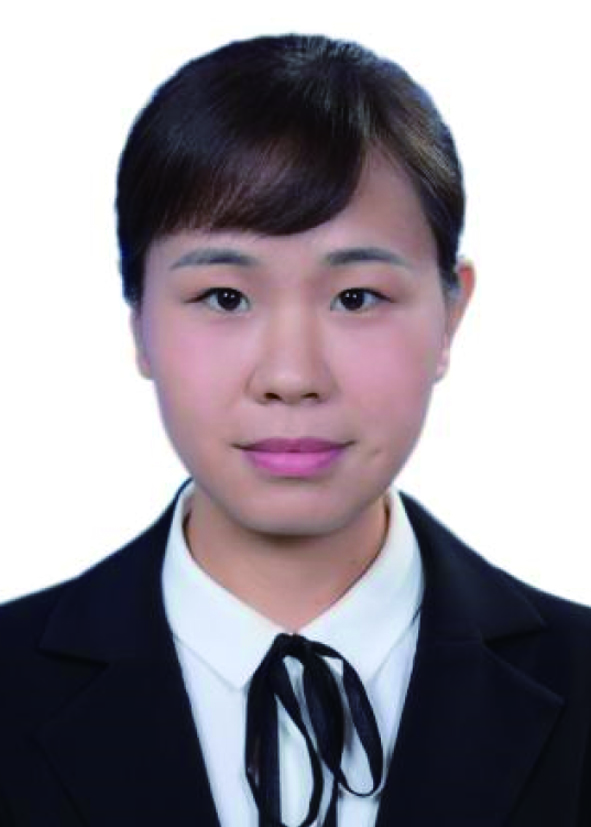 Yiru Wang is a postdoctoral fellow at the Nanjing University of Posts and Telecommunications (NJUPT). She received her Ph.D in Materials Science and Engineering from Nanjing University (NJU) in 2021. She then joined the Institute of Advanced Materials (IAM) at NJUPT. Her research interests focus on organic neuromorphic electronics.
Yiru Wang is a postdoctoral fellow at the Nanjing University of Posts and Telecommunications (NJUPT). She received her Ph.D in Materials Science and Engineering from Nanjing University (NJU) in 2021. She then joined the Institute of Advanced Materials (IAM) at NJUPT. Her research interests focus on organic neuromorphic electronics. Haifeng Ling is a professor at Nanjing University of Posts and Telecommunications (NJUPT). He received his Ph.D in Organic Electronics from NJUPT. He then worked as a postdoctoral fellow at Hong Kong Polytechnic University and as an Alexander von Humboldt postdoctoral researcher at the Max Planck Institute for Polymer Research. In 2019, he joined the Institute of Advanced Materials (IAM) at NJUPT. His research interests focus on organic and flexible neuromorphic electronic devices.
Haifeng Ling is a professor at Nanjing University of Posts and Telecommunications (NJUPT). He received his Ph.D in Organic Electronics from NJUPT. He then worked as a postdoctoral fellow at Hong Kong Polytechnic University and as an Alexander von Humboldt postdoctoral researcher at the Max Planck Institute for Polymer Research. In 2019, he joined the Institute of Advanced Materials (IAM) at NJUPT. His research interests focus on organic and flexible neuromorphic electronic devices.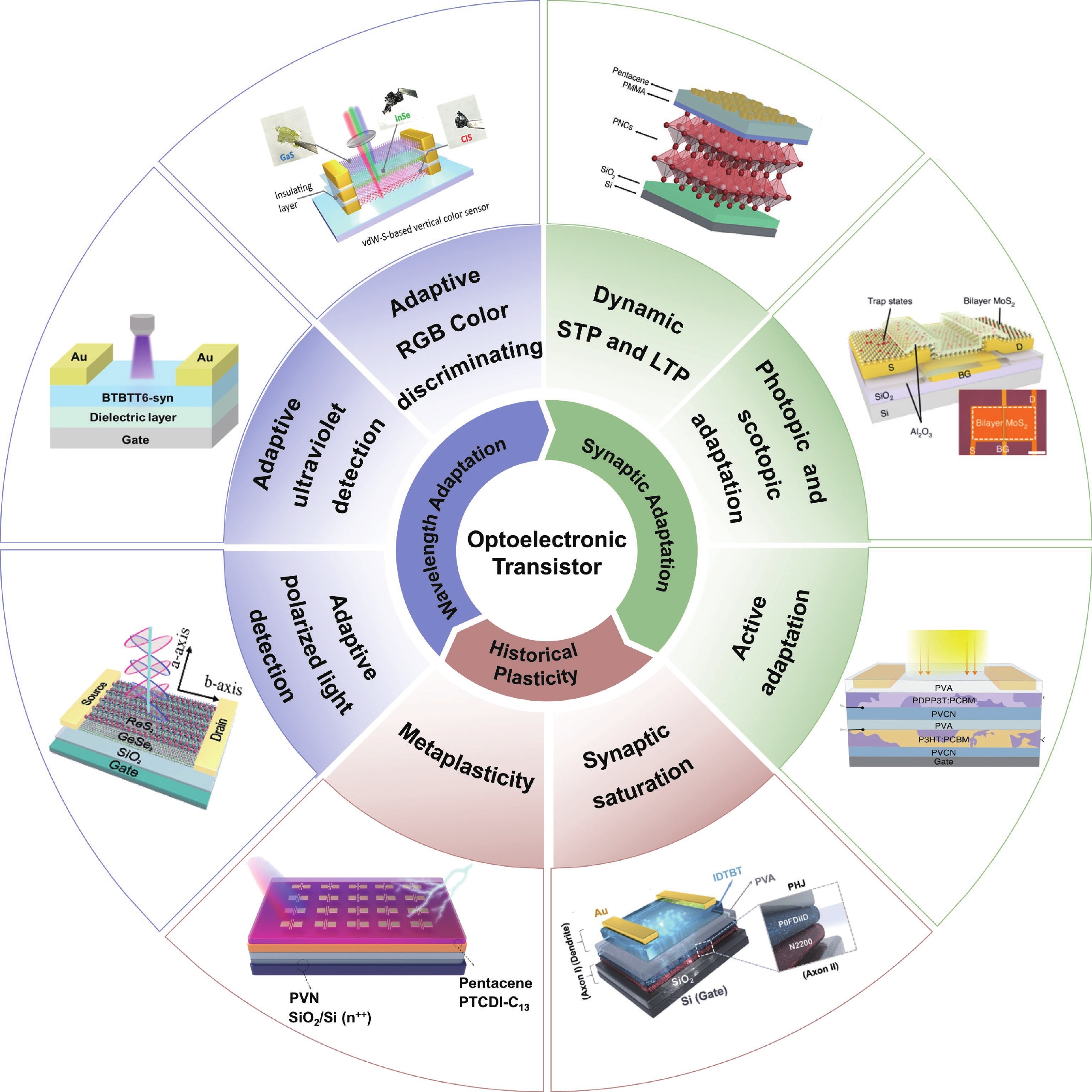
 DownLoad:
DownLoad:
